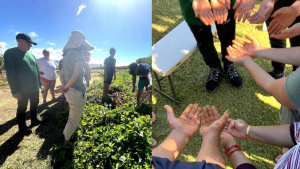
This summer, a group of faculty and staff from the University of Hawaiʻi at Hilo and Hawaiʻi Community College embarked on a transformative journey to Molokaʻi. The huakaʻi (trip), part of UH Hilo’s Uluākea program, featured immersive activities from ʻāina (land) to sea and served as a professional development retreat that deeply engaged participants in Native Hawaiian culture and ʻike (knowledge).

Uluākea, an Indigenous-based program housed at UH Hilo’s Kīpuka Native Hawaiian Student Center, is designed to teach faculty in various academic disciplines at both UH Hilo and Hawaiʻi CC to gain a more authentic and practical understanding of Indigenous ways of knowing the world. The ultimate goal is to integrate these perspectives into teaching practices, enriching the educational experience for students.
“We have applied for and received Title III funding which has enabled us to incorporate the Kaʻao Framework into much of what we do,” said UH Hilo Chancellor Bonnie Irwin. This framework, rooted in traditional Hawaiian mythology, aims to transform the student experience and the overall culture of academia.
Huakaʻi to Molokaʻi

Faculty from various disciplines ventured on the huakaʻi to Molokaʻi on July 11–14. Led by UH Hilo Hawaiian studies lecturer Malu Dudoit, who hails from Maui and Molokaʻi, their journey began with a visit to ʻAnakala (Uncle) Mac Poepoe, a respected konohiki (head person) of the ahupuaʻa (land division) he resides in.
“[He] shared with us stories of his upbringings, traditions of his familial practices, and current issues he faces when working with modern technologies in the practice of ʻāina stewardship and sustainability,” said Dudoit who is facilitator for Uluākea.
The group included a wide mix of educators: Hawaiʻi CC I Ola Hāloa Center for Hawaiʻi Life Styles Coordinator and Hawaiian studies Assistant Professor Noʻel Tagab-Cruz; Hawaiʻi CC Instructors Drew Kapp (geography), Meidor Hu (art) and Jesna Nissam (mathematics); and UH Hilo Associate Professor Christopher Knudson (geography) and visiting professor Nicole Drakos (physics and astronomy).
One of the retreat’s highlights also included a huakaʻi wahi pana o Molokaʻi (journey to storied places on Molokaʻi), guided by Kīpuka peer mentor Kahaku Poepoe, a Hawaiian studies student at UH Hilo and grandson of ʻAnakala Mac Poepoe. He led the group on an exploration of the cultural and historical significance of these places.
Throughout the year, Uluākea conducts workshops on Native Hawaiian protocols, ʻōlelo (language), crafts and ʻāina-based journeys that immerse participants in experiential learning or research.
“The purpose of the retreat was to solidify what each participant has learned throughout the year-long program and to learn how other educators integrate Indigenous knowledge and practices into their curriculum, pedagogy, research, and service to our respective campuses,” said Dudoit.
Pāʻieʻie: Indigenizing campuses
The Pāʻieʻie grant that funds Uluākea, is a $2.99 million award from the U.S. Department of Education. This grant supports efforts to increase Native Hawaiian student enrollment, retention, and graduation rates by creating Indigenous resources and spaces.

—Susan Enright
All photos courtesy of Kīpuka/UH Hilo.
For more, go to UH Hilo Stories.

